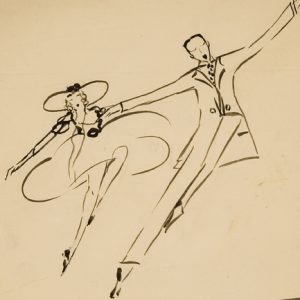The Importance of Loy’s Plays
Although Loy’s plays have been overshadowed by her more celebrated poems and manifestoes of the same period, they were just as important to her, if not more so. “I will try & send you some more poems that will suit,” she wrote to Carl Van Vechten in the mid-teens, “But my whole attention for the moment runs to the impossible play I am so much enjoying writing.”1
The plays have received little critical attention, partly because they have been difficult to access and partly because, well, they’re just difficult. The strange, disjunctive, meta-theatrical comedies defy genre conventions. Siobhan Scarry, who directed the first and only staged reading of The Sacred Prostitute in 2010, classifies them as “poetic drama…plays that draw attention to themselves as literary creations that are never subsumed into the apparent reality of the play.”2
Scholars who write about the plays emphasize their importance to Loy’s feminist critique of Futurism. Julie Schmid contends that they “constitute one of the only feminist responses to and reworkings of the futurist dramatic aesthetic,” and “continue her critique of futurism and women’s place in the movement”3 Recognizing the plays’ significance in Loy’s overarching “project of critiquing avant-garde discourse,” Janet Lyon interprets them as satires of Futurist sexual politics and assertions of an alternative, maternal model of artistic genius.4 These scholars have offered important insights into Loy’s theatrical deployment and interrogation of Futurist aesthetics, yet for the most part in Loy scholarship, the plays remain a footnote in the now-familiar narrative of her critique of Futurist misogyny.
Loy’s Theater as Theory of the Avant-Garde

Loy’s plays warrant further attention because they show her thinking about avant-garde art, performance, and audience in ways that that cannot be contained in any single “-ism,” whether Futurism or sexism. Loy understood that a performance isn’t just about actors but requires and involves audiences. She also recognized that performances play out not only on public stages, but also in private settings and intimate relationships. She used her plays to investigate gendered relationships in art and life, and to develop a nascent feminist theory of the avant-garde.
In putting the avant-garde on stage for analysis, Loy achieves a critical distance from avant-garde attitudes and behaviors, even as she wittily acknowledges her complicity in the problems she diagnoses. Her complex, shifting stance—turning outward in order to scrutinize from within—exemplifies the feminist en dehors garde. Rather than articulating a rational theory, dramatizing a coherent narrative, or even maintaining a consistent dramatic style, Loy adopts a variety of theatrical techniques to stage provisional scenes in which male characters parade and preen, while female characters frequently vie for center stage, only to be displaced to the margins, absorbed into the upholstery, or trapped in cyclical patterns. The plays serve as a way for Loy to examine gendered poses, postures, and performances and test strategies for overturning sexualized power relations.
Loy’s plays are important because they show her practicing a different kind of avant-gardism from her male contemporaries—an en dehors gardism that entails neither contempt for audiences nor naïve claims of artistic autonomy. As Elisabeth Frost and Jessica Burstein demonstrate, Loy’s avant-garde practice is characterized less by revolution and rupture than by a strategic engagement with tradition. According to Frost, “Loy’s poetic practice reveals attitudes toward language that, compared to Marinetti’s, are considerably more attuned to the intransigence of social custom and the elusiveness of revolution.”5 Burstein sets up a similar contrast between the historical avant-garde’s insistence on a violent break with the past and Loy’s radical reinventions of conventions and traditions: “As radical as Loy was in her prosody, she was not simply interested in breaking with tradition,” but in reinventing the traditional, domestic, and banal.6
As we shall see, Loy’s experimental plays draw upon a range of traditional, folk and popular forms, practicing an eclectic en dehors gardism that incorporates elements of puppetry, cinematograph, burlesque, and allegory in an unconventional blend. Loy draws upon popular traditions as a way of engaging and amusing her audiences, even as she delivers biting satires that expose their complicity in the highly gendered, deeply conventional, and inescapably entangled economies of avant-garde art, sex, and commerce.
- Mina Loy to Carl Van Vechten, n.p., undated.
- Siobhan Scarry, “Introduction,” MSA 2010, Poets Theatre Production: The Pamperers, Open Space Gallery, Victoria, B. C.. Nov. 12, 2010.
- Julie Schmid, “Mina Loy’s Futurist Theatre,” Performing Arts Journal, Vol. 18, No. 1 (Jan. 1996), p. 1, 3.
- Janet Lyon, “Mina Loy’s Pregnant Pauses: The Spaces of Possibility in the Florence Writings,” Mina Loy: Woman and Poet, p.397.
- Elisabeth Frost, The Feminist Avant-Garde in American Poetry, Iowa City, University of Iowa Press, 2003, p.30.
- Jessica Burstein, Cold Modernism: Literature, Fashion, Art, University Park, PA: Pennsylvania State University Press, 2012, p.155.